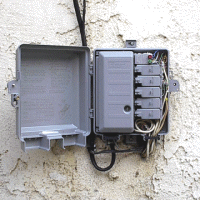mdshunk
Senior Member
- Location
- Right here.
Had a weird DSL problem today, that I managed to solve. I thought I'd pass along the story, since more and more regular electricians are working on this stuff.
Tenant in a commercial building was moving from one office to another in the same complex. Just three lines. Two voice, and one DSL which they also used for their fax and credit card machine. In the phone room, I found their old station cables, the accompanying cross connects wires, and pulled the cross connects. Their new space has a 6-pair going to it. I punched down their three cross-connects to the first three pairs of the 6-pair going to their new space.
Their new space actually has a NID installed in it (weird, eh?). I hooked the appropriate station cables in their new space to the first three pairs of that 6-pair on the NID, called the ANI at each jack to confirm proper operation, and went on to the next job.
Not two hours later, they call (frantic), saying the DSL doesn't work. I came right back, discovered dial tone on the DSL line, but the DSL modem had neither the DSL light or the Internet light lit. What could it be? I was really racking my brain. The only thing I thought it could possibly be was the carbon arrestor in the NID that was in their space. I pulled that pair off the carbon arrestor, and connected it with UR connectors directly to the station cables, completely bypassing the NID and the accompanying carbon arrestor.
I'm not sure what was wrong with this carbon arrestor (maybe nothing?) that it would pass clear dial tone but mess up DSL, but that did the trick. Just passing this along in case this happens to someone else. I'd still like to know why bypassing the carbon arrestor let the DSL connect.
Tenant in a commercial building was moving from one office to another in the same complex. Just three lines. Two voice, and one DSL which they also used for their fax and credit card machine. In the phone room, I found their old station cables, the accompanying cross connects wires, and pulled the cross connects. Their new space has a 6-pair going to it. I punched down their three cross-connects to the first three pairs of the 6-pair going to their new space.
Their new space actually has a NID installed in it (weird, eh?). I hooked the appropriate station cables in their new space to the first three pairs of that 6-pair on the NID, called the ANI at each jack to confirm proper operation, and went on to the next job.
Not two hours later, they call (frantic), saying the DSL doesn't work. I came right back, discovered dial tone on the DSL line, but the DSL modem had neither the DSL light or the Internet light lit. What could it be? I was really racking my brain. The only thing I thought it could possibly be was the carbon arrestor in the NID that was in their space. I pulled that pair off the carbon arrestor, and connected it with UR connectors directly to the station cables, completely bypassing the NID and the accompanying carbon arrestor.
I'm not sure what was wrong with this carbon arrestor (maybe nothing?) that it would pass clear dial tone but mess up DSL, but that did the trick. Just passing this along in case this happens to someone else. I'd still like to know why bypassing the carbon arrestor let the DSL connect.



